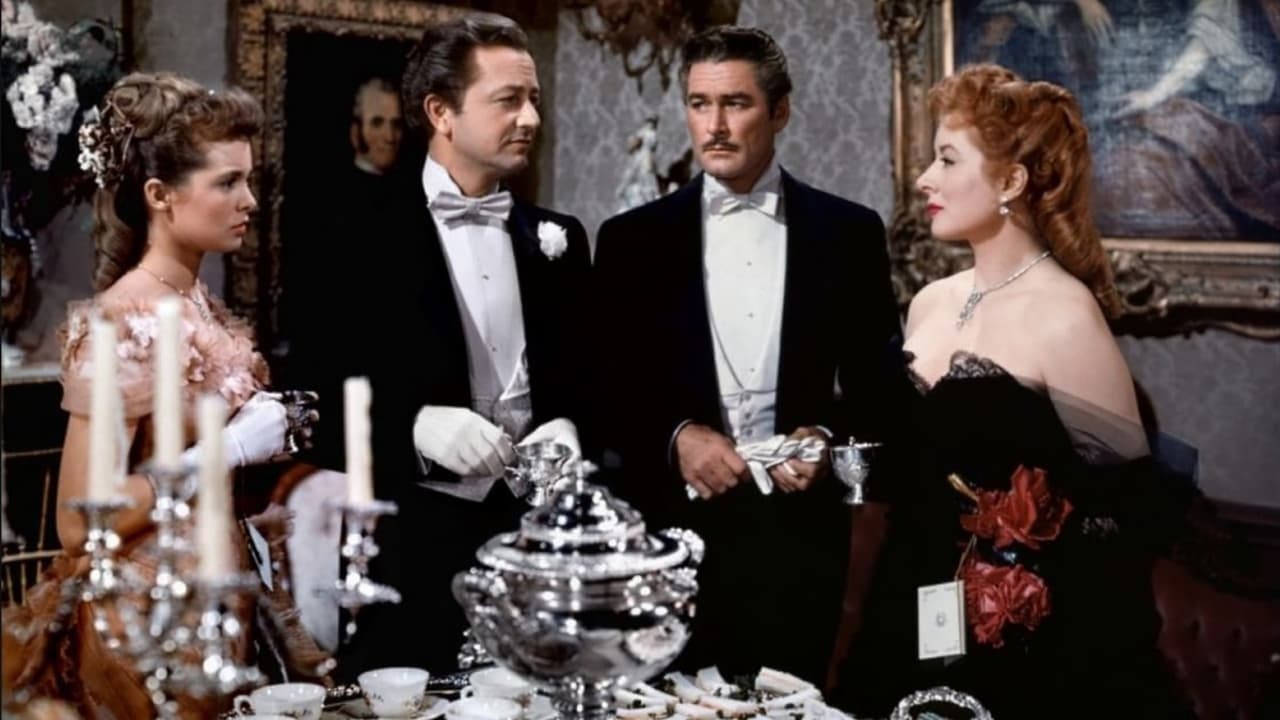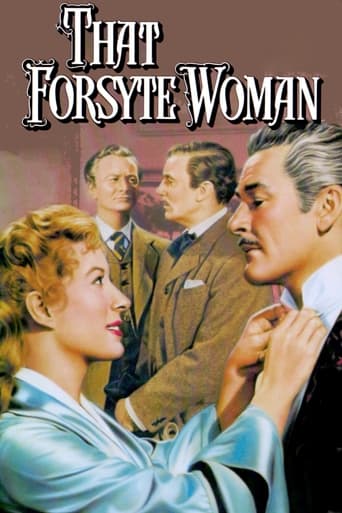

Notable is the absence of children. If this were real life, the hot Errol Flynn and the still fecund (albiet long-in-the-tooth) Greer Garson would have generated children. Is Flynn supposed to be gay? Who knows - he does pick out his wife's outfits and directs her attire, so that's pretty flouncy, but he plays the role super straight, so it is all a bit nutty.The movie's a 7 because of the costuming and the sheer lush absurdity of it all. Walter Pidgeon as an English artist? He's got this super-corporate mid-Atlantic American voice going - again, beyond lunacy.And of course, Janet Leigh - that wild, untamed mid-century Californian, as a stuffy late Victorian Brit? This movie doesn't work on so many levels that it becomes an animal house of conflicting cultures, accents (Harry Davenport - the archetypal midwesterner, plays the patriarch), and appearances (Robert Taylor would make a good grinch who stole Christmas), that it remains irresistible.I think every technicolor movie made in the 1940s is worth watching, so I have a natural bias here. Those of you with less liberal allowances may want to take a pass here, unless you have an insatiable appetite for watching Greer Garson (the reigning "Most Glorious Missus" (i.e, MGM)of the eponymous studio during this period) achieve the amazing combination of (1) suffering, while (2) being so above it all, which she again does very well here, and this time in technicolor.And if you buy into the Ivy League world view, you'll like the movie too: creative artists are the higher order, and the mercenary middle class (i.e., those of who don't have tenure and have to hustle for a living) is scum.Finally, don't come here for any insights into the human condition. Everyone is infantile here ~
... View MoreFirst I need to point out that I have NEVER seen the British Forsyte series, so I cannot possibly compare this movie to it. I have heard that the British series is better and fuller, but I just have no idea if this is true.Second, this movie has among the strangest casting I have seen in some time! Errol Flynn, well-known as a party-animal and womanizer, is cast as the incredibly dull and loveless Soames Forsyte! And, oddly, Walter Pidgeon plays the nice Jolyon Forsyte. Logically, Flynn SHOULD have played the other role and vice-versa, but perhaps the powers that be at MGM couldn't allow "Mr. Miniver" and "Mrs. Miniver" to have a loveless marriage (roles that Pidgeon and Garson were very famous for). Regardless of the reasoning, it actually worked pretty well.As far as Flynn goes, this casting was probably a good decision, as his role was by far the most interesting and enigmatic in the film. While Garson and Pidgeon play likable people and Robert Young plays an ardent suitor, Flynn must play a very cold and cynical man. The expression "he knows the price of everything and the value of nothing" is a great description of him--a fool who might be rich but can't appreciate love or things cash can't buy him. It must have been tough for the dashing Flynn to play such an overly restrained type of character and it was one of the best roles of the later half of his career.Greer Garson essentially plays the stereotypical "Greer Garson" role--you know, the nice and sweet lady you naturally love. And Pidgeon plays essentially the same nice guy role he usually played in the 1940s as well. As far as Robert Young and Janet Leigh, they were important to the plot, but their characters weren't really all that important to the plot--they just helped the story along.Essentially, the story is about very rich and boring old Soames Forsyte (Flynn) pursuing Irene (Garson) very, very ardently. However, his passion and love seems to completely vanish once he marries her--almost like she's a financial acquisition, not a loving wife. Later, Irene meets her niece's boyfriend (Young) and they somehow fall in love. In some ways this is very, very unconvincing--after all, Irene is nice and the idea of her stealing her niece's beau is a bit hard to swallow. But, considering what a cold fish Soames is, I could certainly understand her jumping at the first chance for passion. I just would have liked the movie a little more if the object of her affection were better defined or if this infatuation seemed a bit more believable.Anyways, what exactly happens next, I'll not explore further, as I don't want to spoil the film. So how all this is resolved is just going to have to wait until you see the film. However, I will say that the very best line in the movie was the final one given by Irene. Speaking of now ex-husband Soames, she says "I feel sorry for him,...he's a very poor man". What a fantastic line--a marvelous way to wrap up this excellent film.PS--On a sad note, you might want to compare the Errol Flynn in this film to the same man in movies from just three or so years earlier. I saw this movie as well as OBJECTIVE, BURMA! (1945) and NEVER SAY GOODBYE (1946) all a day or so apart. Despite being made about the same time, Flynn was a lot fatter and puffier in THAT FORSYTE WOMAN due to the effects of alcoholism. Sure he was supposed to be older in this film, but the effects I am talking about were not created by the makeup department. His drinking had finally taken its toll and he looks at least 15 years older just in three years! It's very depressing, really, that he did this to himself--going from a very handsome leading man to a bloated soon-to-be has-been (his films of the 1950s were, for the most part, third-rate messes).
... View MoreJohn Galsworthy's sometimes ponderous but very interesting social drama "The Forsyte Saga" has been attempted as a TV-mini series since this production of a feature film, based on the earlier books of the series, was issued by MGM Studios' heads. The film they produced turned out to be an absolutely-gorgeous color offering, by anyone's standards, featuring costumes by Walter Plunkett and Valles, cinematography by talented Joseph Ruttenberg, and art direction by Daniel B. Cathcart and Cedric Gibbons. The interesting original music for the film was composed by Bronislau Kaper, and Edwin B. Willis produced lovely set decorations. The script for the piece was furnished by Jan Lustig, Ivan Tors and James B. Williams, drawing the events largely from "The Man of Property" by John Galsworthy. In the cast were lovely red- haired Greer Garson as Irene Forsyte, and Errol Flynn as Soames Forsyte, the eponymous new-money tycoon of the "The Man of property"s" original title. Walter Pigeon played young Jolyon Forsyte, whom the family has disowned for following an artistic career, among other complaints. Robert Young was architect Philip Bossinney and respected British actors played the delightfully and frighteningly stuffy Forsyte family including Halliwell Hobbes, Lumsden Hare, Aubrey Mather and more. Janet Leigh played young June Forsyte and Harry Davenport the elder Jolyon Forsyte. With all this talent, the film which is quite good could perhaps have been made even better. Compton Bennett's direction is angular, always interesting and more-than-competent at all points by my standards. The story-line, for those who have never seen it, involves a loveless marriage between Soames Forsyte, who regards his wife as an article of property and Irene, a 19th-century woman who has to marry, being without profession, who grows to despise his miserly nouveau riche pretensions, controlling behavior, and bullyings. She takes up with an excitingly-imaginative architect, who has been hired by Soames to build their new home. Finding out about their attachment, Soames uses his financial power against Bossinney, who grows distraught and then is killed in a street accident. Irene turns to the black-sheep of the family, who had married for love, the artist Jolyon, leaving Soames to confront the colossal failure of his pretensions. The classically-trained Garson and Pigeon are wonderful and memorable in their parts. Flynn tries hard, but lacks a bit of the vocal power he developed soon after this film as released; nevertheless he is more-than-adequate and intelligent in his role. The entire supporting cast ranges from very good to even better by my standards; but their parts seldom allow them to stand out for very long in this look at an entire social class. As a writer, I must suggest that the only loss of power in this strong film appears to stem from MGM's studio heads asking for a script that stressed Soames's emotional coldness; the strongest line of development appeared to have been to stress the tyranny aspect of Soames as versus the regard for individual dignity and rights-- regardless of the wealth owned by any man--on the part of Irene and Jolyon and the other ethical sorts in the work. The film has quite a bit to say about the misuses of power, I suggest; it depicts the imperial side of Britain and the postmodernist unethicals it spawned, folk who never noticed that they were acquisitive types who seemed to admire piracy more than honesty. "That Forsyte Woman" I find to be a very absorbing, beautiful and sobering cinematic production.
... View MoreHow could any woman choose another man over Errol Flynn? I don't know either. That's why I didn't buy the premise of this but was impressed with the performances. Errol Flynn is always great to watch and proves here that he can deliver the acting goods and always of course looks distractingly handsome. Greer Garson and Walter Pigeon are a treat to watch together. A previous poster mentioned the fact that Greer Garson having an adulterous affair didn't work because she was just too likable really doesn't apply here because the fact that their marriage is unhappy is established. Robert Young comes off less sympathetic than Flynn's Soames Forsythe, in my opinion. Here he takes advantage of the young and naive June Forsythe and the unhappy marriage of Mrs. Forsythe at the same time. The story is contrived but overall a good flick to watch on a rainy day. I would recommend it.
... View More